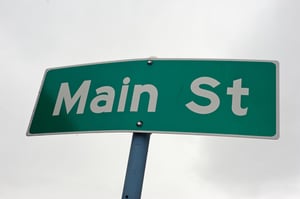
Now we find that many of our Cities all have one thing in common: Main Street is also a State Highway. And therein lies the problem - you want people to stop and enjoy all Main Street has to offer, and you also want to move people along the Highway. This begs the question, how can these two opposing purposes coexist?
I am a big supporter of the Complete Streets design approach. The idea that our roads should be designed to provide mobility to all users is a concept that seems fundamentally correct. In practice, this has been changing the design approach to focus more on pedestrian, bicyclist and transit. These users have long been neglected in a traditional auto-centric design approach. With the Complete Streets movement gaining momentum, more and more places are looking for ways to integrate these new policies into their communities. The desire to build healthier communities, safer streets, and increase economic vitality is growing.
Recently, a reader posed a question about using Complete Streets design concepts on corridors with high freight traffic. It made me realize something: We cannot forget that in many instances Main Street must also serve another purpose - the movement of freight by trucks. The goal is to find the balance between policy and mobility.
The purpose of Complete Streets is to provide mobility to all users, including freight, but many times they are forgotten during policy making, planning, outreach, and design. Freight traffic is typically not local to the community and so their input is not sought, creating a situation where freight is left out or added as an afterthought. There are ways to fix this, and in the coming weeks we will be posting several blogs that will provide options for handling freight traffic.
I'd love to hear your thoughts on this. You can reach me by leaving a comment below, or by emailing me at dteran@mackaysposito.com. Stay tuned: In our next post we’ll talk about how to give freight the boot off Main Street (and why they’ll thank you for it).
Check out our other posts in this series:
Implementing a Complete Street Policy (part 2)
Can Complete Streets and Freight Mobilty Coexist? (part 3)
Photo credit: © Can Stock Photo Inc. / CrystalMage


Leave us a comment below